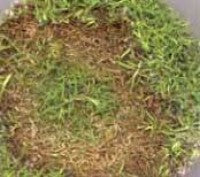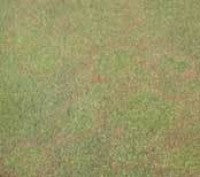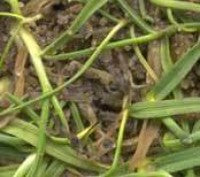Turfgrass Diseases – What’s around now?
Turfgrass Diseases - What's around now?
By Kate Entwistle
It doesn't matter what time of the year you look at turfgrasses, you will always be able to find the fungi that cause disease. However, the symptoms that they are causing may be so minor that they go unnoticed and cause no concern for us with regard to maintenance. That said, there always tends to be some disease active during the year and at the moment there are three things to keep a look out for.
Firstly, fusarium patch disease. This disease has been active for several weeks although areas that have had the recent warm weather may have seem some recovery from the disease. It has been showing up on and off for several months and looking very different on the sward depending on the grasses affected. I have seen many cases of fusarium patch disease where the pale pink fungal mycelium has been growing around the edge of the affected patches, cases of 'text book' patch development (Fig.1) and other outbreaks (on creeping bentgrass) where the sward has simply developed many patches of dark brown turf (Fig.2).

|

|
| Figure 1 | Figure 2 |
Although all turfgrasses can be affected by this disease, Poa annua is the most likely grass to show infections. Management of this disease varies considerably. I know many turf managers who allow the disease to 'run its course' and wait for changes in the weather conditions to halt the development of the disease. Others apply fungicides to manage the problem and there are still many effective products available for use. What's right for one may not work for another but if you want to manage this disease with chemicals, you need to catch it early to prevent severe crown damage.
In addition to fusarium patch, there seems to be a lot of superficial basidiomycete activity at the moment on fine turfgrass areas. Many turf managers are now reporting rings, arcs or patterns that resemble superficial fairy rings (Fig.3) but with is no apparent mycelium evident at the base of the sward or in the thatch. The mycelium of some of these fungi is so fine that it may not be possible to see it when looking at a sample of the rootzone but incubation of a sample in a plastic bag for a few hours, may allow sufficient growth of the fungus for you to smell its presence in the rootzone.
These fungi generally have a characteristic musty smell that will be obvious if present.Even if the mycelium of the fungi is not apparent, it is possible to find evidence of the fungi in the base of the sward, assuming you know what to look for. Some of these basidiomycetes will produce small resting structures (sclerotia) as seen here in Fig.4. They may not always be black in colour but their presence will help to confirm that the effect on the sward has been caused by a superficial basidiomycete. This type of disease development generally appears much worse than it actually is. They tend to disappear as the temperature increases and generally don't require any specific treatment. These fungi, although they can cause unwanted symptoms expression on the sward for short periods of time, are saprophytic organisms whose presence in the turf is predominantly beneficial. Recognising these often ephemeral symptoms can often prevent time consuming and costly management practices.

|

|
| Figure 3 | Figure 4 |
Finally, there are many areas of fine turf that are now showing a red discoloration that can be easily confused with the disease red leaf spot which develops on bentgrasses.This current problem often shows as very obvious patches of reddened turf that, on close inspection, are frequently found to be patches of reddened Poa annua in a mixed turfgrass sward. Red leaf spot disease, which commonly occurs during the spring, is only seen on bentgrass turf and so an accurate identification of the affected plants will help to discount this disease as the cause of the current problem. If the sward is showing reddened patches, it is quite likely that the plants are showing a reaction to recent cold weather that has brought about a dominance of the red pigment 'anthocyanin' in the leaf. If this is the cause of the problem, the affected leaves will either show the reddening only on the exposed side of the leaf (the underside will remain green) or, the reddening will be apparent around the edge of the leaves, depending on the grass type affected.
Keep a close eye on any sward discoloration and get the cause of the problem confirmed if you are in any doubt. Accurate identification will ensure effective management.
Dr Kate Entwistle, The Turf Disease Centre, Waverley Cottage, Sherfield Road, Bramley, Hampshire RG26 5AG. UK Tel: 01256 880246
